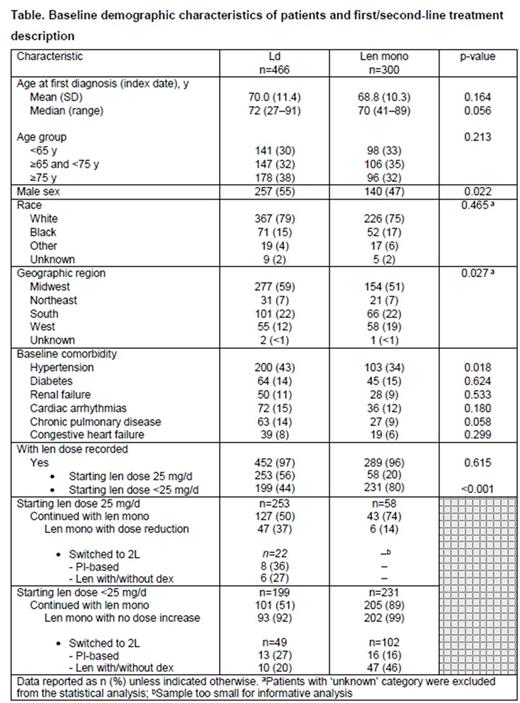Abstract
Introduction: Doublet combinations including lenalidomide (len) and dexamethasone (dex; Ld) are increasingly used to treat frontline (FL) multiple myeloma (MM) patients (pts). Len has also been used as maintenance therapy where strategies increasing len dose with first relapse have been considered (Harousseau JL et al. Blood 2017). Triplet combinations are emerging as standard of care for relapsed/refractory (RR) MM and the treatment paradigm is shifting, with new agents like carfilzomib, ixazomib, elotuzumab, and daratumumab being added to Ld. Although these new combinations have shown improved clinical outcomes in RRMM, most pts ultimately relapse. Thus, treatment decision with each relapse becomes increasingly important to improve survival; the most critical decision may come at first relapse. With earlier len use, better understanding of treatment sequencing patterns of len and its use in clinical practice settings may help optimize treatment strategies in RRMM pts in later lines. We present real-world clinical practice data on treatment sequencing at relapse from len-based FL therapy.
Methods: Pts aged ≥18 y with ≥1 diagnosis (International Classification of Diseases [ICD], 9th Revision, codes 203.0x or ICD-10 codes C90.0x), preceded by ≥12 mo (baseline) without a MM claim, were identified from January 1, 2010 in the Explorys electronic medical records US database and followed through the course of available follow-up. FL therapy included all anti-MM treatment received after 1st claim for an anti-MM prescription or administration of anti-MM therapy. The end of a line of therapy (LoT) was defined as the 1st day of a treatment gap of >90 d or initiation of a salvage regimen. LoT escalation was a surrogate for disease progression. Baseline characteristics plus Ld and len monotherapy (mono) patterns of use were summarized using descriptive statistics.
Results: 766 FL pts were treated with Ld (466 [61%]) or len mono (300 [39%]). Pts in the 2 cohorts were similar in age and race; males and pts in the US Midwest region (Table) tended to receive Ld vs len mono. Pts on Ld generally had more comorbidities vs pts on len mono. Of 466 pts on Ld, 97% (n=452) had a recorded len dose, of whom 56% (n=253) started len at 25 mg/d and 44% (n=199) at <25 mg/d. Of 253 pts who started len at 25 mg/d, 127 (50%) stopped dex during Ld after a median (IQR) duration of therapy (DoT) of 40 (28-120) d and continued with len mono; 47 (37%) of these pts then had len dose reduced (24 on 15 mg/d, 16 on 10 mg/d, 7 on <10 mg/d). Of the 47 pts with len dose reduced, 22 later switched to second-line (2L) therapy. Proteasome inhibitor (PI)-based regimens (n=8 [36%]) and len with/without dex (n=6 [27%]) were most commonly used in 2L. Of the 199 pts receiving low-dose len with dex, 49% (n=98) stayed on Ld while 51% (n=101) discontinued dex after a median (IQR) DoT of 28 (28-80) d and continued with len mono maintenance. Of 101 pts who discontinued dex, 92% (n=93) had no len dose reduction; of these, 53% (n=49) switched to 2L therapy. A PI-based regimen (27%) and len with/without dex (20%) were the primary 2L treatment choices. Of the 300 pts receiving len mono in FL, 96% (n=289) had a recorded len dose: 80% (n=231) started at <25 mg/d, 20% (n=58) at 25 mg/d. Of 231 pts starting low-dose len, 89% (n=205) had no dex added in FL therapy and 99% (n=202) of those had no len dose increase. Among pts with no len dose increase, 102 had 2L therapy, of whom 16% (n=16) and 46% (n=47) had a PI-based regimen and len with/without dex, respectively, when relapsed from FL treatment. Of 58 pts starting len at 25 mg/d, 74% (n=43) had no dex added; of those, 14% (n=6) had len dose reduced.
Conclusions: In real-world clinical practice, about half of pts receiving Ld as FL therapy moved to len mono maintenance therapy; over one-third of these had their len dose reduced. Of pts with reduced len dose, ~50% relapsed and switched treatment in 2L. PI-based regimens and len re-treatment were the most common 2L therapy options after progression on len in FL. Pts on Ld were more likely to progress to 2L if they started treatment with low-dose len. Pts receiving low-dose len were less likely to have len dose increased. Findings suggest the increasing importance of optimizing treatment strategies in RRMM pts who receive len as FL therapy, including use of new triplets, especially for early relapse. Analysis of outcome data is currently ongoing.
Study support: Bristol-Myers Squibb
Chen: Bristol-Myers Squibb: Employment. Potluri: SmartAnalyst Inc.: Employment; Janssen: Consultancy, Research Funding. Kanakamedala: SmartAnalyst Inc.: Employment. Papademetriou: SmartAnalyst Inc.: Employment. Yasenchak: Bristol-Myers Squibb: Consultancy; Seattle Genetics: Consultancy. Ranjan: SmartAnalyst India Pvt. Ltd: Employment. Bhandari: SmartAnalyst India Pvt. Ltd: Employment. Mann: SmartAnalyst India Pvt. Ltd: Employment. Davis: Bristol-Myers Squibb: Employment.
Author notes
Asterisk with author names denotes non-ASH members.


This feature is available to Subscribers Only
Sign In or Create an Account Close Modal